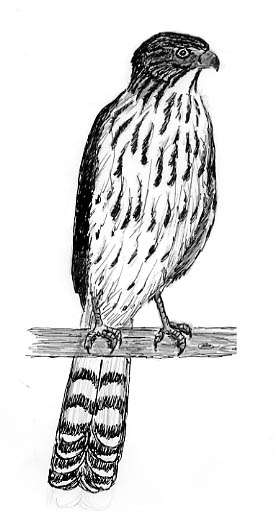
Dear Bird Folks,
Last week you mentioned hawks scaring away birds from feeders. You are so right. I have a small hawk that is keeping all the birds away from my feeder. What kind of hawk is it and how do I get rid of it?”
– Charles, Chatham
Whoa Charles,
Get rid of it? You finally get some excitement in Chatham and you want to get rid of it? Are you kidding me? You should sell tickets.
The two most common backyard hawks are Cooper’s Hawks and the very similar Sharp Shinned Hawks (look’em up). Both of these hawks can be seen year round, but are far more common in the winter. They move down from the frozen north and love to zip through our yards looking for songbirds. They are very fast hawks and usually don’t sit and pounce like the more visible Red-Tailed Hawk. Instead, the Cooper’s and Sharp Shinned Hawks flash along at low level and, if they find a songbird, the chase is on. Often times the birds that smack our windows are trying to escape a hawk attack.
I know, you think that it is just dreadful that hawks are picking on your sweet little songbirds. You would think that hawks would have enough morals to only eat those ever abundant tofu finches or the soy jays. But the hawks are just responding to an increasing food supply. As bird feeding increases, there is reason to believe that the population of feeder birds will also increase, thus causing an increase of predators. Just like areas with the highest human population have the most lawyers.
Don’t worry about the cute little birds, they can take care of themselves. Most of the time the best ones get away, it’s the boneheads that get chowed. And even the dumb ones have more of a chance to escape than the birds that some people eat out of a bucket at Kentucky Fried Chicken. I don’t hear you sticking up for those birds.
I find that most people have their feeders in the open to keep away the jumping squirrels, and also to see them better. But exposed feeders put feeder birds at risk during the cold months when the hawks are the most abundant. If you have a hawk around, and you’ll know that you do because you won’t have many birds around, you might try moving your feeders to a more sheltered area. A location that has lots of thickets or bushes will give the birds a plce to hide when a hawk comes blasting through. Doing this will not only help protect birds coming to eat at your feeder, but also make you need to buy more bird seed – that’s the part we like the best.
So don’t think poorly of the hawks, Charles, they are just looking for a meal like you and everyone else. And I’d be willing to bet that even the oldest hawk has eaten fewer birds over its lifetime than you have. And the hawk doesn’t have a choice, nature has programmed it that way. You, on the other hand, should try one of those soy jays. They taste much better than chicken, especially if you ask a chicken.